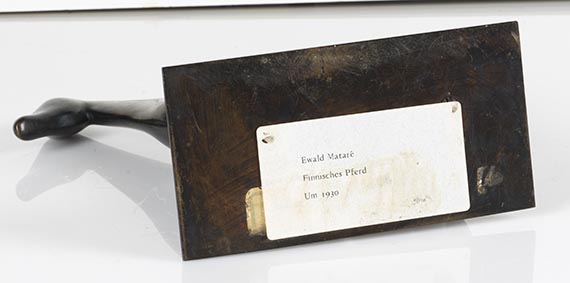Video
Autre image
Autre image
Autre image
Autre image
468
Ewald Mataré
Finnisches Pferd, 1929/30.
Bronze with brown patina
Estimation:
€ 50,000 / $ 58,500 Résultat:
€ 82,550 / $ 96,583 ( frais d'adjudication compris)
Finnisches Pferd. 1929/30.
Bronze with brown patina.
With the artist's signet on the horse's underside and in center of the plinth. One of 14 known copies. 26.5 x 23 x 6 cm (10.4 x 9 x 2.3 in). [EH].
We are grateful to Dr. Kufferath (née Schilling), Düren, for her kind support. The work will be listed under no. 72b. in the newly revised edition of her yet unpublished catalogue raisonné.
As Mataré had the bronzes cast on demand, neither an exact number nor a definitive year can be determined.
• Accomplished sculpture by the great master of animal bronzes.
• Ewald Mataré made an important contribution to German sculpture, particularly with his works from the 1920s/30s.
• Further copies can be found in the Suermondt-Ludwig-Museum, Aachen and the Museum of Atlanta, Missouri.
PROVENANCE: Galerie Wilhelm Grosshennig, Düsseldorf
Private collection North Rhine-Westphalia.
LITERATURE: Sabine M.Schilling, Ewald Mataré. Das plastische Werk, Cologne 1987, no. 66 b (illu.).
Bronze with brown patina.
With the artist's signet on the horse's underside and in center of the plinth. One of 14 known copies. 26.5 x 23 x 6 cm (10.4 x 9 x 2.3 in). [EH].
We are grateful to Dr. Kufferath (née Schilling), Düren, for her kind support. The work will be listed under no. 72b. in the newly revised edition of her yet unpublished catalogue raisonné.
As Mataré had the bronzes cast on demand, neither an exact number nor a definitive year can be determined.
• Accomplished sculpture by the great master of animal bronzes.
• Ewald Mataré made an important contribution to German sculpture, particularly with his works from the 1920s/30s.
• Further copies can be found in the Suermondt-Ludwig-Museum, Aachen and the Museum of Atlanta, Missouri.
PROVENANCE: Galerie Wilhelm Grosshennig, Düsseldorf
Private collection North Rhine-Westphalia.
LITERATURE: Sabine M.Schilling, Ewald Mataré. Das plastische Werk, Cologne 1987, no. 66 b (illu.).
Ewald Mataré (1887 Aachen - 1965 Büderich), German sculptor and graphic artist, initially studied painting under Lovis Corinth at the Academy of Art in Berlin between 1907-1914, before switching to sculpture in the 1920s. Unique woodcuts with reduced depictions of animals and his sculptural work made Materé famous. It was his ability to reduce the animals' bodies to flat basic forms that gave them a contemporary, modern appearance. With his animal sculptures, especially his depictions of horses and cows, Mataré developed a unique trademark that clearly distinguished his work from that of other animal sculptors such as August Gaul or René Sintenis. Wood was his preferred material, the natural grain of which the artist niftly used for the expression of his works.
Mataré's first horse sculpture, the so-called " Junge Pferd" (Young Horse), was made in 1924. The artist created the first wooden version of this enchanting bronze in Toijala, Finland, near the Estonian border, where Ewald Mataré spent the summer months of 1929. In contrast to other slightly different versions of a horse, the legs in this case are joined together; omitting other details such as eyes, nostrils or the characteristic mane, Mataré achieved a more rigorous line in order to condense the entire form with clear contours and emphasize the essence of the animal, its slender, graceful character. The smooth, polished surface and the graceful contours of the sculpture naturally encourage observers to experience the wonderful haptic appeal of holding and caressing it. "Sculpture lives in real space, painting in the imaginary, that is a fundamental difference, and just as painting is perceived with the eye, sculpture should be perceived with the hand. [..] The creative process is not determined by light and shadow, and blind people should also be able to enjoy a sculpture." (Ewald Mataré: Ein Wort über Plastik, 1928, in: Hanns Theodor Flemming, Ewald Mataré, Munich 1955, p. 74)
Body and limbs of this "Finnish horse" are fine and well-proportioned, it stands gracefully and tall with its head raised. It signals attention, the legs, placed together, give the body a firm posture, a highly elegant posture, too, which unites all the qualities worthy of a horse, such as grace, composure and concentration. [MvL]
Mataré's first horse sculpture, the so-called " Junge Pferd" (Young Horse), was made in 1924. The artist created the first wooden version of this enchanting bronze in Toijala, Finland, near the Estonian border, where Ewald Mataré spent the summer months of 1929. In contrast to other slightly different versions of a horse, the legs in this case are joined together; omitting other details such as eyes, nostrils or the characteristic mane, Mataré achieved a more rigorous line in order to condense the entire form with clear contours and emphasize the essence of the animal, its slender, graceful character. The smooth, polished surface and the graceful contours of the sculpture naturally encourage observers to experience the wonderful haptic appeal of holding and caressing it. "Sculpture lives in real space, painting in the imaginary, that is a fundamental difference, and just as painting is perceived with the eye, sculpture should be perceived with the hand. [..] The creative process is not determined by light and shadow, and blind people should also be able to enjoy a sculpture." (Ewald Mataré: Ein Wort über Plastik, 1928, in: Hanns Theodor Flemming, Ewald Mataré, Munich 1955, p. 74)
Body and limbs of this "Finnish horse" are fine and well-proportioned, it stands gracefully and tall with its head raised. It signals attention, the legs, placed together, give the body a firm posture, a highly elegant posture, too, which unites all the qualities worthy of a horse, such as grace, composure and concentration. [MvL]
468
Ewald Mataré
Finnisches Pferd, 1929/30.
Bronze with brown patina
Estimation:
€ 50,000 / $ 58,500 Résultat:
€ 82,550 / $ 96,583 ( frais d'adjudication compris)




 Lot 468
Lot 468 